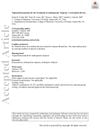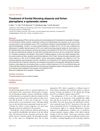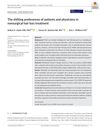Switching to Dutasteride because finasteride couldn't stop my hair loss. Finasteride/Dutasteride 3/4/2025
The user switched from Finasteride to Dutasteride due to continued hair loss, using Dutasteride twice a week while continuing Finasteride on other days, and also using Minoxidil and Ketoconazole shampoo. They are considering increasing Dutasteride dosage and are uncertain about continuing Minoxidil due to lack of visible results.
View this post in the Community →
Similar Community Posts Join
6 / 1000+ resultscommunity 4 months using finasteride | minoxidil | ketoconazole | dermaroller (update)
User "mo_movic" shared 4-month progress using finasteride, minoxidil, ketoconazole, and dermaroller for hair loss. Others congratulated and discussed their own experiences, with "mo_movic" reducing finasteride dose and using ketoconazole twice a week.
community My journey from Norwood 3.5/4 to Norwood 0
A user's hair regrowth journey involved a hair transplant and using RU58841, finasteride, and minoxidil, with side effects managed by other medications.
community Taking Charge of Your Hair: The "Big 3 Stack" Explained for 2023
The "Big 3 Stack" for hair loss treatment, which includes Minoxidil for hair density improvement, Ketoconazole shampoo for enhancing hair volume and thickness, and Finasteride for blocking hair loss causing hormones. Microneedling can boost Minoxidil's effects.
community COMPLETE OVERVIEW of the Treatment of androgenetic alopecia in men
Male androgenetic alopecia is commonly treated with topical minoxidil and oral finasteride, both requiring continuous use. Other options include hair restoration surgery, dutasteride, light therapy, and camouflaging agents.
community You should start with finasteride only
Begin with finasteride to evaluate its effectiveness before adding minoxidil. Combining treatments may enhance results but could also increase side effects; individual responses differ.
community 25M | 10 years of gradual hair loss | Minoxidil user | Looking for input on treatment optimization before HT
A 25-year-old male with 10 years of hair loss is using minoxidil and considering adding finasteride or dutasteride, possibly with microneedling, to improve hair regrowth before a hair transplant. Community members suggest starting a DHT blocker immediately, considering oral minoxidil, and addressing low vitamin D and HDL levels.
Related Research
6 / 1000+ results
research Topical Ketoconazole for the Treatment of Androgenetic Alopecia: A Systematic Review
Ketoconazole may help regrow hair and increase follicle size, but more research needed.

research Treatment of Frontal Fibrosing Alopecia and Lichen Planopilaris: A Systematic Review
No effective treatment for frontal fibrosing alopecia was found, but oral 5-alpha-reductase inhibitors had the best response; for lichen planopilaris, topical corticosteroids were commonly used but had a high relapse rate.

research Male Pattern Baldness: Current Treatments, Future Prospects
Current treatments for male pattern baldness include minoxidil and finasteride, with new options being developed.

research Experimental and Early Investigational Drugs for Androgenetic Alopecia
New hair loss treatments may include topical medications, injections, and improved transplant methods.

research The Shifting Preferences of Patients and Physicians in Nonsurgical Hair Loss Treatment
Minoxidil and Finasteride are the most popular hair loss treatments, with rising interest in other options, and economic or health crises can change what treatments people prefer.

research An Update on Hair Restoration
Hair transplantation is the best treatment for hair loss, with new technologies improving results, and stem cell and gene therapies may treat severe baldness in the future.